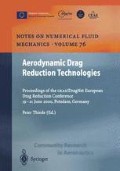Summary
Basic experiments on transitional flow physics for swept wings are performed at DLR-Göttingen supporting the theoretical-numerical work (see the corresponding CEAS/DragNet-contribution by Janke et al.). One common aim is to predict and to control boundary-layer transition as reliable and simple as possible. The DLR swept flat plate transition experiment provides the setup with a crossflow dominated three-dimensional boundary-layer flow, to investigate the stabilization with the aid of surface suction through holes and slots. An effective and resistant attenuation of the disturbances initiating transition can be reached. One objective of this study is to quantify the effectiveness and robustness, i.e. the flow control sensitivity on suction device imperfections and variations. Another objective is the prediction of transition for the design of Hybrid Laminar Flow (HLF) transport-aircraft wings. This attempt requires experimental informations for physical modeling of the origin of boundary-layer instability. Therefore, the impact of vortical freestream disturbances on the receptivity of three-dimensional boundary layers is evaluated. A major goal is to identify the mechanism(s) that cause the final breakdown of a swept wing’s three-dimensional boundary layer into a fully turbulent flow regime. With a controlled excitation of primary and secondary traveling disturbances, the appearance and growth of high-frequency secondary instability are investigated upstream of breakdown. Two high-frequency secondary modes are identified in agreement with theoretical predictions. Finally experiments using a wing with a thickness ratio of 15%, the damping effect of the convex surface curvature on disturbance growth is demonstrated and transition scenarios different from the DLR swept flat plate transition experiment become obvious.
Dedicated to the memory of Hans Bippes, our friend and colleague as well as long-time spiritus rector for experimental laminar-turbulent transition research at DLR in Göttingen.
Access this chapter
Tax calculation will be finalised at checkout
Purchases are for personal use only
Preview
Unable to display preview. Download preview PDF.
References
Bippes H. (1999) Basic experiments on transition in 3D-boundary layers dominated by crossflow instability. Progress in Aerospace Sciences 35: 363–412.
Pöthke A. (1999) Grundlegende Untersuchungen zum laminar-turbulenten Umschlag an der konvex gekrümmten Oberseite eines schiebenden Tragflügels. Diss. thesis Physics Dep., Univ. Göttingen.
Bippes H., Wiegel M., Bertolotti F. (1998) Experiments on the control of crossflow instability with the aid of suction through perforated walls. Proc. IUTAM Sym. FLOWCON, Göttingen, Sept. 7–11, 1998.
Abegg C., Bippes H., Janke E. (1999) Stabilization of boundary-layer flows subject to crossflow instability with the aid of suction. Proc. IUTAM Sym. Lam.-Turb. Transition, Sedona, Sept. 13–17, 1999.
Deyhle H., Bippes H. (1996) Disturbance growth in an unstable three-dimensional boundary layer and its dependence on environmental conditions. J. Fluid Mech. 316: 73–113.
Kendall J.M. (1990) Boundary-layer receptivity to freestream turbulence. AIAA 21st Fluid Dyn. Conf., Seattle, June 18–20, 1990: AIAA 90–1504.
Boiko A.V. (1999) Flat plate boundary-layer response to controlled freestream axial vortices, In Proc. 11th Int. Couette-Taylor Workshop, Bremen, July 20–23, 1999: 111–112.
Lerche T. (1997) Experimentelle Untersuchung nichtlinearer Strukturbildung im Transitionsprozeß einer instabilen dreidimensionalen Grenzschicht. Fortschr.-Ber. VDI Reihe 7 Nr. 310. Düsseldorf.
Koch W., Bertolotti F.P., Stolte A., Hein S. (2000) Nonlinear equilibrium solutions in a three-dimensional boundary layer and their secondary instability. J. Fluid Mech. 406: 131–174.
White E.B., Saric W.S. (2000) Application of variable leading-edge roughness for transition control on swept wings. AIAA 38th Aerosp. Sci. Meeting, Reno, Jan. 10–13, 2000: AIAA 2000–0283.
Abegg C. (2000) Experimental investigation on the effectiveness, robustness and sensitivity of surface suction panels with respect to HLF control. To appear as DLR-Report.
Author information
Authors and Affiliations
Editor information
Editors and Affiliations
Rights and permissions
Copyright information
© 2001 Springer-Verlag Berlin Heidelberg
About this paper
Cite this paper
Abegg, C. et al. (2001). Transitional Flow Physics and Flow Control for Swept Wings: Experiments on Boundary-Layer Receptivity, Instability Excitation and HLF-Technology. In: Thiede, P. (eds) Aerodynamic Drag Reduction Technologies. Notes on Numerical Fluid Mechanics (NNFM), vol 76. Springer, Berlin, Heidelberg. https://doi.org/10.1007/978-3-540-45359-8_22
Download citation
DOI: https://doi.org/10.1007/978-3-540-45359-8_22
Publisher Name: Springer, Berlin, Heidelberg
Print ISBN: 978-3-642-07541-4
Online ISBN: 978-3-540-45359-8
eBook Packages: Springer Book Archive

